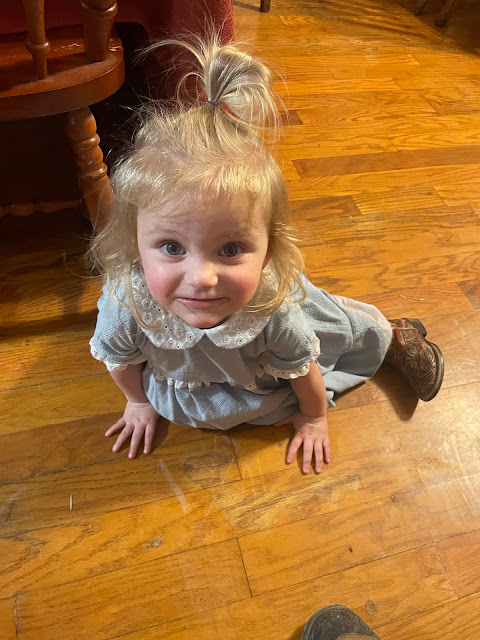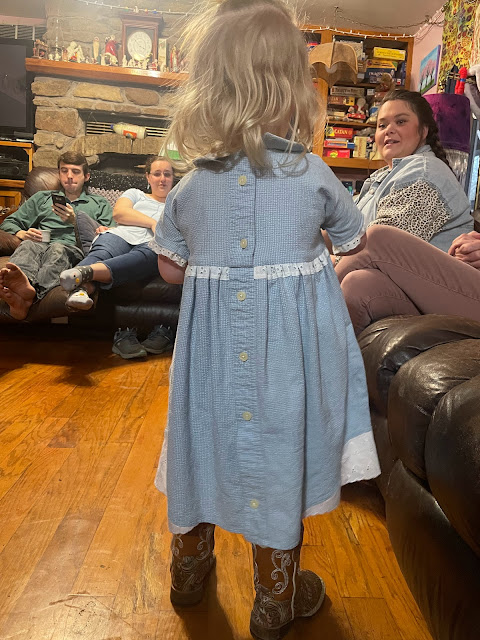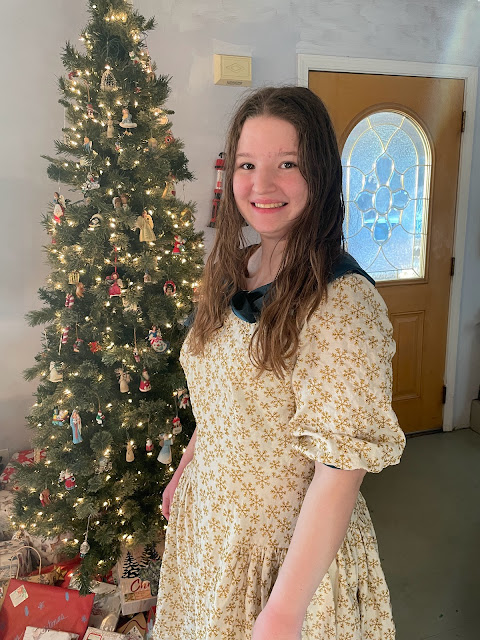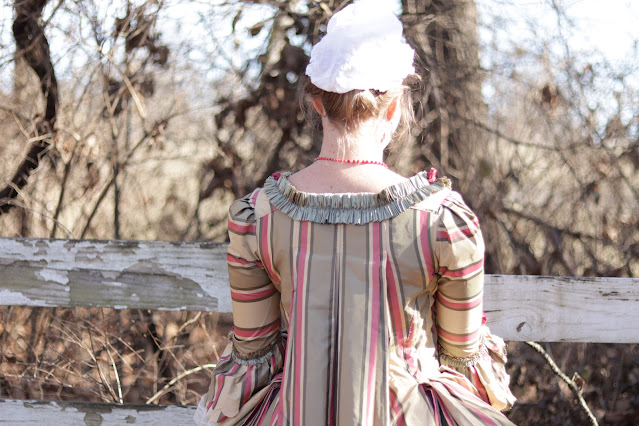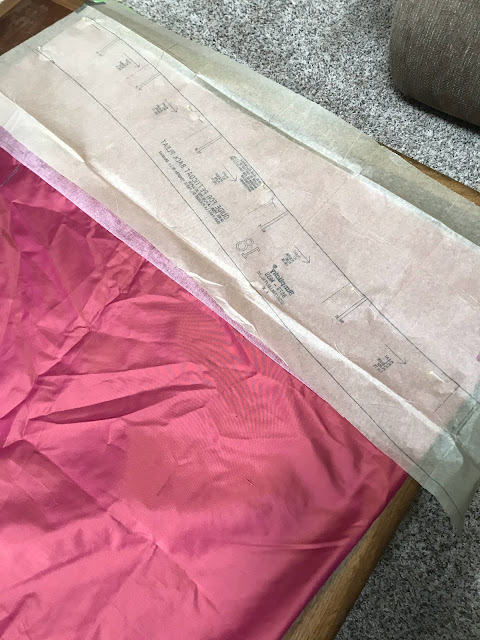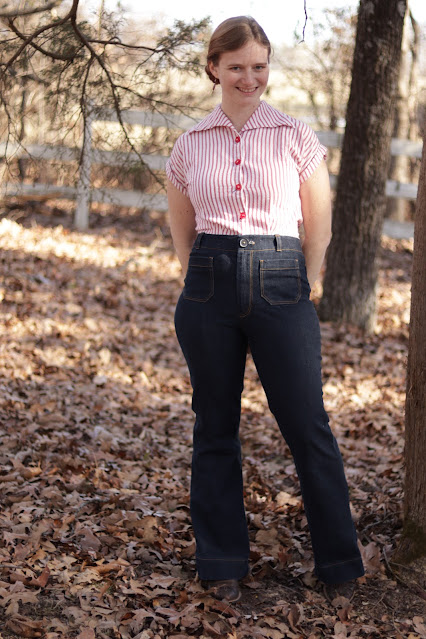I was very excited this weekend to see my niece wearing a dress I made for her last spring, (She has worn the dress since I gave it to her, I just haven't been around to see it until now.)
Sewing and Raising Alpine Dairy Goats. . . and occasionally finding time to do other stuff
Pages
Monday, January 30, 2023
A Blue Seersucker Shirt to Toddler Dress Refashion
Saturday, January 28, 2023
My Sister's Golden Snowflake Christmas Dress
Golden Snowflakes were the theme of this year’s Christmas Dresses.
We decided we simply had to buy 4 yards to make her a Christmas dress.
So we did.
After returning to my apartment we set about planning this dress.
We decided to use the Charm Patterns Night and Day Dress pattern, with the yoked skirt, elbow length bishop sleeves, and the round neckline with the collar.
Ok, so we’d actually planned to do the long bishop sleeves, but when I went to cut the dress out 2 months later I discovered we had not bought enough fabric for that idea, so elbow length sleeves it would be.
Since my niece’s dress was going to be gold snowflake fabric with red “trim”, we decided my sister’s dress should be trimmed with green.
Thus, I bought a dark green crepe-backed satin for the collar and cuffs. (Yes, I probably did have some sort of dark green fancy fabric in my stash that would have worked for this, however, due to moving and all that entailed, I did not have a chance to go back to my parents’ house and dig through my fabric stash to find such a thing prior to starting this dress. Thus, buying 1/2 a yard of new fabric it was)
There’s not much to say about the construction of the dress. I lined the bodice with a Christmas print from my stash and the sleeves and skirt are both unlined.
It closes up the back with a lapped zipper.
I finished the dress about a week and a half before Christmas and was able to send it home with my sister when she and my parents came to visit!
She wore it to church on Christmas morning, and then to the Christmas gathering with my mom’s family the day after Christmas.
Where she gave my grandpa this gorgeous American Flag blanket she crocheted for him.
A week later she wore it again for our family Christmas.
She’d intended to make herself a green shawl and belt to wear with the dress, but thanks to all the gifts she was making for other people, that didn’t happen. (Who else can relate to that? 🙋♀️)
Oh well, she, and the dress, looked great regardless!
And maybe next Christmas she’ll get that belt and shawl made and wear the dress again!
Saturday, January 21, 2023
The "Golden Rose" 1770's Silk Petticoat
On a visit with my friend @historicthimble over a year ago, she went through a bin of fabric. Out came an abandoned project - a striped silk pet en l'air, nearly half finished. Having no interest in finishing it herself, she offered it to me.
Well I wasn’t going up say no to silk! I gratefully accepted the grocery bag of begun 18th century jacket and silk scraps. It wasn’t my size, but 18th century construction is forgiving so I knew I could re-fit it. A pet en l'air is the shortened version of a Robe a la Francaise, or Sack-Back gown. It has a fitted lining under double box pleats in the back. The pleats are stitched down at the neckline and then free-flow loose down the back. My friend had finished the back pleats and lining. The front of the pet needed to be sewn to the lining and the sleeves still needed to be cut out.
I took the grocery bag of silk back to my parents’ one weekend for a trip through my fabric and pattern stashes.
There were enough silk scraps in the bag for sleeves, sleeve ruffles, and robings, (and I could use my Larkin and Smith English Gown pattern to cut out those pieces and re-fit the bodice lining) however there would not be enough silk to trim the pet the way I wanted, and I would need to figure out a petticoat to go with it - there wasn’t enough silk for that either.
Surly my “very healthy” fabric stash would yield something for trims and a petticoat!
The fabric was stripped green, fuchsia, and gold. A look through my fabric stash revealed silk shantungs and taffetas in similar shades. Scraps of gold and ivory shantung, picked up at estate sales, thrift stores, and the like would be used for trimming. Nearly 2 yards of fuchsia taffeta, acquired from Sewstine when she was destashing a couple years ago, would do for the petticoat. And the green shantung, left over from this petticoat, would complete any trim deficiencies.
With this settled, I decided to start with the easy part - the petticoat.
Just shy of 2 yards wasn’t quite enough for a petticoat so some piecing was required. From the silk I cut the front panel of the petticoat about the length I thought it needed to be. This made the piece of silk I had for the back panel 10”-12” shorter than I required. So I cut a strip of cotton about that wide and pieced it onto the top of the back panel with a narrow mantua maker's seam. The top cotton section would be covered by the skirts of the pet en lair when the ensemble was worn. In the 18th century the unseen parts of petticoats were often made from cheaper fabrics with the expensive silk saved for the visible areas, so this was a perfectly period appropriate solution to not enough fabric.
And sewed on twill tape waist ties.
The Challenge: Geometry - the petticoat is entirely constructed of rectangles. The front is one rectangle. The back is 2 - the top third of the back is a rectangle of cotton (not seen when the petticoat is worn with a jacket or gown) and the bottom 2/3rds is a rectangle of silk. All of the trim (including the roses!) is gathered rectangles of silk.
Material: Silk taffeta and cotton sheeting.
Pattern: none for the majority of the petticoat, but I did use Simplicity 8578 as a template to get the top shape correct for going over pocket hoops.
Year: 1760’s and 1770’s
Notions: thread
How historically accurate is it? It’s all hand sewn, and my material choice is accurate. It’s even accurate to use a cheaper fabric for the parts of the petticoat that won’t be seen, the way I did. However, that “cheap” fabric would be more likely to be linen, rather than the cotton I used. The trim pattern is decent I think, though I didn’t base it off an extant garment. The petticoat definitely came out a bit on the short side as I was short on silk. So let’s say 85-90%.
Hours to complete: I’m not sure. The petticoat itself went together quickly, but the trim took forever!
First worn: For Pictures, 12/28/22
Total cost: The silk was given to me by a friend who was de-stashing. Everything else was stash, left over from other projects. So $0.
Saturday, January 14, 2023
Testing the Isle Jeans
Blue Jeans. The majority of mine are still store-bought. Shirts and tops? Just about all are me-made. Same with dresses, skirts, and pants that aren’t jeans. But jeans? Well I can make them. I have made them. I’ve collected plenty of denim to make myself some more to replace my fast wearing-out thrifted jeans. However, I just haven’t made the collection of jeans I’ve intended too. Other sewing projects keep distracting me.
That said, I really didn’t expect to get picked as a tester. Chalk and Notch is a pretty popular pattern company and they usually have a lot of testing applicants so I don’t often get picked. Thus, I was completely surprised, and very excited, when I did get picked this time!
And also a little nervous. You see, I applied to test this pattern right after our offer on our house had been accepted, and the test would take place the week before we closed on our house. Hopefully I could manage it!
The printer and my sewing stuff would just need to be some of the last things we packed before moving. . . I could get this done!
Thankfully I already had all the materials I needed in my stash - stretch denim, top stitching thread, and a jeans zipper.
Now I only had two yards of the stretch denim I wanted to use, not the 3 yards required for my size, but with some careful laying out, I made it work.
I cut out a size 10 as I’d recently gained a bit of weight and that was the size that best matched my new measurements.
As expected with Chalk and Notch patterns the instructions were very thorough and give you a professional looking garment when followed.
As this was a pattern test, I was a good girl and took the time to read, follow, and give feedback on the instructions.
In my normal sewing instructions often get ignored.
I finished the jeans two days before we closed on our house - my very last sewing project in the apartment. After that my sewing area was all packed up.
Very comfortable. Honestly, with as much as the denim stretches, I should have made a size smaller than I did.
I fully intend to make myself another pair or two in the correct size from the final pattern. I have more denim in my stash!
Thank you Chalk and Notch team for choosing me to test this pattern so I would finally add another pair of me-made jeans to my wardrobe!
*I received this pattern for free in exchange for testing but I was not required to blog about it in any way, shape, or form.








